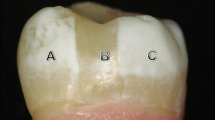Abstract
Aim:
To prevent decalcification during orthodontic treatment using fixed appliances, many orthodontists use sealants to protect the enamel surface around the brackets. If the patients’ oral hygiene is insufficient, air polishing devices are often used to clean the teeth. The aim of this study was to investigate the effects of air polishing on the sealant.
Material and Methods:
Three sealants (Pro Seal™, OrthoSolo™, and Seal&Protect® were used in this study. Each was applied on the surface of 30 extracted human teeth. The enamel surfaces of 10 teeth each were then air polished with the sodium-bicarbonate-based powder (Air-Flow®) 5 or 10 seconds, or the glycine-based powder (Clinpro™ Prophy) for 10 seconds.
Results:
The sealant had become thinner, revealing minor defects after 5 seconds of air polishing using the sodium-bicarbonate-based powder, practically disappearing after 10 seconds. Use of the glycine-based powder allowed longer air-polishing times, but the sealant surface also showed minor defects thereafter.
Conclusion:
Reliable protection against demineralization may be seriously compromised after sealed tooth surfaces are cleaned with air-polishing devices. This finding correlates with the type of powder and air-polishing time.
Zusammenfassung
Ziel:
Um Demineralisationen während einer Multibracketbehandlung zu vermeiden, versiegeln viele Kieferorthopäden das Bracketumfeld. Ist die Mundhygiene suboptimal, werden die Zähne mit Hilfe von Pulver-Wasser-Strahlgeräten gereinigt. Die vorliegende Arbeit sollte die Frage klären, ob die Reinigung mit Pulver-Wasser-Strahlgeräten und verschiedenen Strahlmitteln die Schicht der Glattflächenversiegelung beeinträchtigt.
Material und Methodik:
Drei Glattflächenversiegler (Pro Seal™, OrthoSolo™, Seal&Protect®) wurden auf je 30 extrahierte Zähne aufgetragen. Anschließend wurde die Oberfläche bei je 10 Zähnen 5 bzw. 10 Sekunden mit einem Natriumbikarbonat-basierten Strahlmittel (Air-Flow®) bzw. 10 Sekunden mit einem Glycin-basierten Strahlmittel (Clinpro™ Prophy) behandelt.
Ergebnisse:
Nach 5 Sekunden Behandlung mit einem Natriumbikarbonat-basierten Strahlmittel war die Versieglerschicht ausgedünnt bzw. wies Lücken auf. Nach 10 Sekunden war der Versiegler nahezu abgetragen. Die Verwendung von Glycin-basierten Strahlmitteln ermöglicht längere Strahlzeiten, wobei auch hier die Glattflächenversiegelung kleine Schäden aufwies.
Schlussfolgerung:
Nach der Zahnreinigung mit Pulver-Wasser-Strahlgeräten kann abhängig vom verwendeten Strahlmittel und von der Strahldauer unter Umständen nicht mehr mit der gewünschten Schutzfunktion der Glattflächenversiegelung gerechnet werden.
Similar content being viewed by others
References
Banks PA, Richmond S. Enamel sealants: a clinical evaluation of their value during fixed appliance therapy. Eur J Orthod 1994;16:19–25.
Barnes CM, Russel CM, Gerbo LR, et al. Effects of an air-powder polishing system on orthodontically bracketed and banded teeth. Am J Orthod Dentofacial Orthop 1990;97:74–81.
Buonocore MG. A simple method of increasing the adhesion of acrylic filling materials to enamel surfaces. J Dent Res 1955;34:849–853.
Buren JL, Staley RN, Wefel J, Qian F. Inhibition of enamel demineralization by an enamel sealant, Pro Seal: an in-vitro study. Am J Orthod Dentofacial Orthop 2008;133:S88–S94.
Davies TM, Shaw WC, Worthington HV, et al. The effect of orthodontic treatment on plaque and gingivitis. Am J Orthod Dentofacial Orthop 1991;99:155–161.
Diedrich, P. Bracket-Adhäsivtechnik in der Zahnheilkunde. München-Wien: Carl Hanser Verlag, 1983.
Farrow ML, Newman SM, Oesterle LJ, Shellhart WC. Filled and unfilled restorative materials to reduce enamel decalcification during fixed-appliance orthodontic treatment. Am J Orthod Dentofacial — Orthop 2007;132:578. e1–e6.
Gerbo LR, Barnes CM, Leinfelder KF. Applications of the air-powder polisher in clinical orthodontics. Am J Orthod Dentofacial Orthop 1993;103:71–73.
Ghiz MA, Nyan P, Kuo E, et al. Effects of sealant and self-etching primer on enamel decalcification. Part II: an in-vivo study. Am J Orthod Dentofacial Orthop 2009;135:206–213.
Gorelick L, Geiger AM, Gwinnett AJ. Incidence of white spot formation after bonding and banding. Am J Orthod 1982;81:93–98.
Heinig N, Hartmann A. Efficacy of a sealant: study on the efficacy of a sealant (Light Bond) in preventing decalcification during multibracket therapy. J Orofac Orthop 2008;69:154–167.
Hu W, Featherstone JD. Prevention of enamel demineralization: an in-vitro study using light-cured filled sealant. Am J Orthod Dentofacial Orthop 2005;128:592–600; quiz 670.
Jost-Brinkmann P-G. Wirkungen und Nebenwirkungen von Pulver-Wasser-Strahlgeräten bei regelmäßiger Anwendung in der Orthodontie. Aachen: Verlag Mainz, 1997.
Jost-Brinkmann P-G, Schiller RA, Jost-Brinkmann B. Untersuchung zur Häufigkeit transitorischer Bakteriämien durch Zahnreinigung mittels Pulverstrahlgeräten. Quintessenz 1994;45:1677–1687.
Oshawa T. Studies on solubility and adhesion of the enamel in pretreatment for caries preventive sealing. Bull Tokyo Dent Coll 1972;13:65.
Silverstone LM. Fissure sealants: the susceptibility to dissolution of acid-etched and subsequently abraded enamel in vitro. Caries Res 1977;11:46–51.
Tanna N, Kao E, Gladiwn M, Ngan PW. Effects of sealant and selfetching primer on enamel decalcification. Part I: An in-vitro study. Am J Orthod Dentofacial Orthop 2009;135:199–205.
Tanna N, Kao E, Gladiwn M, Ngan PW. Effects of sealant and selfetching primer on enamel decalcification. Part II: An in-vivo study. Am J Orthod Dentofacial Orthop 2009;135:206–213.
Zachrisson BU, Zachrisson S. Caries incidence and oral hygiene during orthodontic treatment. Scand J Dent Res 1971;79:394–401.
Zachrisson BU, Zachrisson S. Caries incidence and orthodontic treatment with fixed appliances. Scand J Dent Res 1971;79:183–192.
Zero DT. Dental caries process. Dent Clin North Am 1999;43:635–664.
Zimmer B. Systematic decalcification prophylaxis during treatment with fixed appliances. J Orofac Orthop 1999;60:205–214.
Author information
Authors and Affiliations
Corresponding author
Rights and permissions
About this article
Cite this article
Engel, S., Jost-Brinkmann, PG., Spors, C.K. et al. Abrasive Effect of Air-powder Polishing on Smoothsurface Sealants. J Orofac Orthop 70, 363–370 (2009). https://doi.org/10.1007/s00056-009-9917-y
Received:
Accepted:
Published:
Issue Date:
DOI: https://doi.org/10.1007/s00056-009-9917-y




